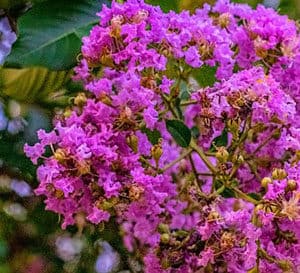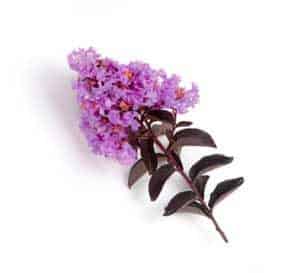Crape murder is a term credited to a 1997 article in Southern Living magazine that refers to the needless late fall and winter practice of cutting crapemyrtles down to stubs.
Why Crape Murder?
Many people commit crape murder because they think it promotes better blooms in the coming year. Still others commit crape murder because their crapemyrtle has outgrown the spot where it was planted. Regardless of the motive, crape murder is not only unnecessary; it is detrimental.
Severe pruning or topping of crapemyrtles removes strong, viable limbs and encourages the growth of weak and flimsy shoots that often aren’t strong enough to support the blooms come spring and summer. It also keeps crapemyrtles from forming the unique and lovely bark that makes these trees spectacular additions to the landscape even when the leaves are off in winter. And the cuts made at pruning can allow disease and rot to enter a crapemyrtle, which can eventually result in its untimely demise.
Selective Pruning
Prune only selectively in late winter to clean up random shoots or open up the canopy a bit. Late winter is the best time to do this type of pruning before the trees leaf up so you can really see those random shoots. It’s also fine to cut back any crossed or dead branches and to trim side branches from the trunk so the growth is higher. The goal in crapemyrtle pruning is to do it discretely so it’s barely obvious that you pruned at all. For step-by-step instructions on how to prune crapemyrtles from Southern Living’s The Grumpy Gardener, click here.
Healing Process
If you’ve got crapemyrtles that have suffered from past crape murder attacks, all is not lost. Simply stop cutting them back this year and selectively prune shoots that emerge from the base of the trunk and larger branches. For truly severe cases of crape murder, try cutting them back to within a couple of inches of the ground and letting them regrow. As they remerge, snip away almost all the shoots except for the straightest, strongest ones and let them establish new structure for the tree.
If all else fails, go ahead and put damaged crapemyrtles out of their misery by digging them up and replacing them with just the right crapemyrtle for your setting.
Southern Living® Crapemyrtles
It’s easy to find the perfect crapemyrtle for any location, and the Southern Living Plant Collection offers several crapemyrtle options that may be just right.

For a smaller tree, try the Early Bird™ Lavender Crapemyrtle, which grows 4 to 6 feet in height and 3 to 4 feet in width. For slightly larger options, try Early Bird Purple™ or White™, both of which grow to heights of 5 to 8 feet and widths of 3 to 4 feet. These beauties are aptly named since all three begin blooming by Mother’s Day—earlier than most crapemyrtles—and rebloom throughout the summer.

If a bigger tree is what you need, Southern Living® Plant Collection’s Delta Series Crapemyrtles may be just the solution. These stunning varieties produce dazzling flowers, have unique burgundy cupped leaves and grow 8 to 12 feet high and 4 to 6 feet wide.













